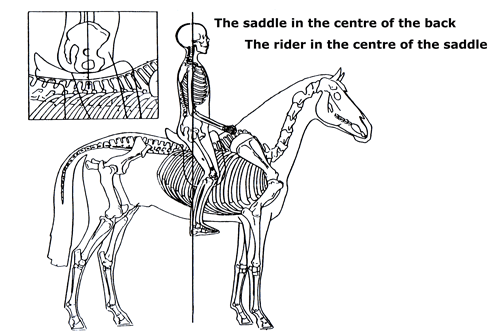A Balancing Act
A
horse is said to be 'in balance’ when its own weight and that
of the rider are carried as an evenly distributed load through all
paces. It is the ability of the horse to reestablish his natural
balance under the rider's weight that makes this possible. It should
therefore not be difficult to appreciate how much more difficult this
will be for the horse if the saddle itself is ‘not in
balance’.It
is accepted that the horse is better suited to pull rather than to
carry. The horse's back is not constructed so as to be capable of
tolerating more than moderate downward pressure. It follows therefore
that as soon as a saddle is fitted there is 'potential for a problem1.
In other words, it could be said that the professional Saddle Fitter is
onto a 'hiding to nothing' since he is required to fit something which
should not be there in the first place, onto an area of strictly
limited dimensions, since it must fit behind the scapula (shoulder
blade) and no further back than the last rib since no weight should be
imposed on the loins.It
is absolutely crucial that the saddle is not positioned too far forward
since this will impede the free movement of the shoulder blade causing
discomfort for the horse and a corresponding reduction in performance.
It will also be impossible for the saddle to sit level and balanced
unless it sits in its natural position on the back and behind the
scapula. Moreover, a saddle placed too far forward will oblige the
rider to sit on the back of the seat imposing their weight on the back
half of the panel only. This I believe is the most common cause of many
back problems.Therefore
to check that a saddle is sitting in balance, when viewed from the
side, the deepest part of the seat should be in the centre of the
saddle positioning the rider so that their weight is evenly distributed
over the whole bearing surface of the panel.It
is sometimes the case that a saddle can be a perfect fit and yet is
subsequently blamed for causing back problems simply because it has
been placed too far forward, causing the rider to sit on the back of
the seat, thereby causing excessive pressure on a small area of the
back.Saddle
design and construction was largely influenced by nineteenth century
cavalry officers and it was a Major Francis Dwyer who recognised the
importance of a balanced seat. He believed that if the rider's weight
was carried correctly over the horse's "centre of motion" this would
enable the horse to move freely without interference to its natural
balance. This however could not be achieved unless the rider's weight
was evenly distributed over the total bearing surface so minimising the
possibilities of pressure points. Dwyer argued that the rider would be
positioned over the fourteenth dorsal vertebra which he believed to be
the 'centre of motion of the horse's body'.With
the kind permission of the distinguished equestrian author Elwyn
Hartley Edwards, I reproduce a diagram depicting the rider sitting
perfectly in balance, centrally in the seat and over Dwyer's 'centre of
motion’, the fourteenth vertebra. It also appears to show
that part of the panel can impinge on the area of the loins. However,
even if this is sometimes the case, it is preferable to placing the
saddle over the shoulder and out of balance.
 Therefore
it is the position of the saddle on the back that is of paramount
importance. As I have said, even if the saddle is a perfect fit, if its
position on the back is out of balance, the rider's position and the
horse's ability to perform will be compromised. Neither the horse nor
the rider will be balanced unless the saddle itself is in balance to
start with. As an eminent riding master once said "position comes first
and everything else comes after".
Therefore
it is the position of the saddle on the back that is of paramount
importance. As I have said, even if the saddle is a perfect fit, if its
position on the back is out of balance, the rider's position and the
horse's ability to perform will be compromised. Neither the horse nor
the rider will be balanced unless the saddle itself is in balance to
start with. As an eminent riding master once said "position comes first
and everything else comes after".
 Therefore
it is the position of the saddle on the back that is of paramount
importance. As I have said, even if the saddle is a perfect fit, if its
position on the back is out of balance, the rider's position and the
horse's ability to perform will be compromised. Neither the horse nor
the rider will be balanced unless the saddle itself is in balance to
start with. As an eminent riding master once said "position comes first
and everything else comes after".
Therefore
it is the position of the saddle on the back that is of paramount
importance. As I have said, even if the saddle is a perfect fit, if its
position on the back is out of balance, the rider's position and the
horse's ability to perform will be compromised. Neither the horse nor
the rider will be balanced unless the saddle itself is in balance to
start with. As an eminent riding master once said "position comes first
and everything else comes after".